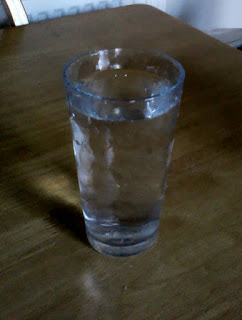“You’re not sick; You’re thirsty” – Dr F Batmanghelidj
A warm and sunny Sunday afternoon and I should be tidying
the garden. Instead, I’m sitting at my desk (or at least what passes for one)
trying to summon up suitably refreshing words to share an astonishing discovery
with my followers and friends.
That’s right. Water.
A guy called Phil put me onto it – or, at least, reminded me
how beneficial H2O can be. Phil is an alternative therapist who practices
bio-resonance, harnessing electro-magnetic frequencies to attack and obliterate harmful
parasites, viruses and bacteria. All
quite painless, I assure you, having had this treatment myself, but not this
time.
On this occasion, it is my 80+ friend Doreen who is being scanned. She’s lying on a very comfy chair and holding a short metal rod in each hand. These are conductors, designed to hunt down any unwelcome ‘squatters’ in her body so they can then be zapped into oblivion.
On this occasion, it is my 80+ friend Doreen who is being scanned. She’s lying on a very comfy chair and holding a short metal rod in each hand. These are conductors, designed to hunt down any unwelcome ‘squatters’ in her body so they can then be zapped into oblivion.
Sitting behind a desk, Phil is monitoring his electro-magnetic
machine. It seems Doreen has a water infection. “You’re also badly dehydrated,” he
says, “need to drink more water.”
“Ah, water!” I exclaim. As Doreen’s designated driver, I
was allowed in to take notes of anything Doreen might not remember - though,
truth be told, despite being older than me, her brain’s a lot sharper. But hey,
two heads are better than one.
“Yes, water,” says Phil, warming to his theme, “It’s the
best therapy you can have. You’d be amazed how many conditions it can alleviate
and even cure. There was a man in here a while ago with kidney
problems…..shrunken like raisins they were.
Doctors had told him he’d need dialysis but all he really needed was
water. I gave him a pint to drink, then another and another and, by the time
he’d finished, his kidneys were working properly. The water plumped them up.”
“Would that work on wrinkles?” I ask.
“Oh yes,” Phil nods. “Water plumps up the skin like nothing else does....as well as keeping you healthier. In Ireland, the word whiskey means
‘water of life’. Keeps the brain working too.” He then told us about an elderly
relative who lived in a nursing home. “Alzheimers,” he explains. “When I go to
see her she doesn’t recognise me at first, so I get a glass of water, stick in
a straw and say, ‘Here’s the drink you asked for, Grandma’. She’ll have a few sips then
push it away, and a minute later I’ll pass it back to her. ‘Here’s that drink
you asked for’, and just keep giving her more. Eventually she’ll look at me and
say ‘Hello, love!’ It’s the water, you see? Without it, the brain shrinks.
‘Most people don’t realise how dehydrated they are. The
brain doesn’t tell you when you need water, so by the time you feel thirsty,
you’re already dangerously dehydrated.
‘Do you know….” Phil leans forward earnestly. “…..more
people die of drowning in the desert than from lack of water? True! Most people found dead have water with
them. And the older you are, the less thirsty you become, the less water you
drink and the more the brain is impaired. Tea and coffee don’t help much…they’re
diuretics and you just don’t get the same benefit. It has to be pure water to
make any difference.”
“So how much should you drink a day?” I ask.
‘For an adult - 3 pints per day - minimum. I have a good 8
pints myself, one before I even get out of bed and I drink water with
every meal. It detoxes the system, sharpens your mind and helps you stay young.”
That's convinced me! “Is there any more information on water?”
“There’s a doctor with a strange first name….something like
Doctor Batman*….anyway, he’s written a book about water and its many health
benefits. Google it and you’ll find out why the Irish call it the water of
life!”
Which I do as soon as I get home. ‘Doctor Batman’ is Fereydoon Batmanghelidj
(b.1931 - d.2004) an Iranian from a wealthy family who was imprisoned after the
revolution in 1979. Though sentenced to death, he was spared in order to treat
his fellow inmates at Evin Prison. During this incarceration he discovered the
merits of water, having no other therapy available, and was so amazed by the
results, he later wrote “Your Body’s Many
Cries for Water” which claims that chronic dehydration is the root cause of
many ailments. This controversial view has had its detractors, of course, but Dr
Batmanghelidj stuck to his guns and his findings.
In his opinion, a dry mouth is not one of the first symptoms
of dehydration but one of the last. He further stated that people’s ability to
recognise thirst decreases with age. As a result, they drink less and age even
faster.
Some medical conditions Dr Batmaghelidj claimed could be alleviated
by water include:
Asthma, allergies, obesity, high blood cholesterol, heart
disease, stroke, diabetes, hypertension, confusion, memory loss, depression, chronic
fatigue, lack of energy, problems sleeping, addiction, osteoporosis, leukaemia,
lymphoma, hot flushes, gout, kidney stones, attention deficit.
Dr Batmanghelidj also asserted that dehydration could
contribute to cancer and auto-immune disorders, including AIDS.
How true these claims are is open to debate. For me, it
makes sense that drinking more can, at the very least, cleanse and hydrate the
body. At worst, it will certainly not do any harm.
So have one on me….at least 3 times a day…..and see if it
makes a difference!
‘




















